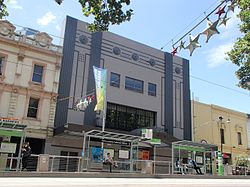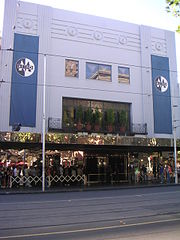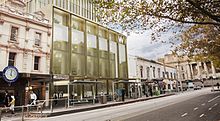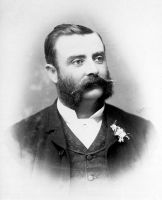
William Pitt was an Australian architect and politician. Pitt is best known as one of the outstanding architects of the "boom" era of the 1880s in Melbourne, designing some of the city's most elaborate High Victorian commercial buildings. He worked in a range of styles including Gothic Revival, Italianate, French Second Empire, and his own inventive eclectic compositions. He had a notable second career after the crash of the 1890s, becoming a specialist in theatres and industrial buildings.

The Capitol is a theatre on Swanston Street in the central business district (CBD) of Melbourne, Victoria, Australia. Opened in 1924 as part of the Capitol House building, the theatre was designed by American husband and wife architects Walter Burley Griffin and Marion Mahony Griffin. It is the oldest of Melbourne's large picture palaces and is known for its extravagant decor and abstract motifs, including an intricate geometric ceiling containing thousands of coloured lights designed to evoke the walls of a crystalline cave.

The Hotel Windsor is a luxury hotel in Melbourne, Victoria, Australia. Opened in 1884, the Windsor is notable for being Melbourne's only surviving purpose-built "grand" Victorian era hotel. The Windsor pre-dates other notable grand hotels including The Waldorf Astoria in New York, the Raffles Hotel in Singapore, the Ritz in Paris and the Savoy in London.
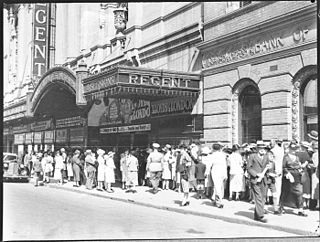
The Regent Theatre was a heritage-listed cinema and entertainment venue in George Street, Sydney, New South Wales, Australia, built in 1928 as a flagship for Hoyts, and was demolished in 1988 by property developer Leon Fink.
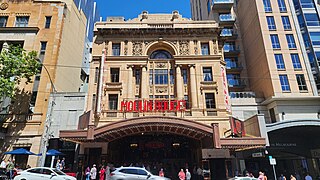
The Regent Theatre is an historic former picture palace built in 1929, closed in 1970, and restored and reopened in 1996 as a live theatre in Collins Street, in the city of Melbourne, Australia. It is one of six city theatres collectively known as Melbourne's East End Theatre District. Designed by Cedric Heise Ballantyne in an ornately palatial style, with a Gothic style lobby, Louis XVI style auditorium, and the Spanish Baroque style Plaza Ballroom in the basement, it is listed by the National Trust of Australia and is on the Victorian Heritage Register.
John Ian Wing is an Olympic bronze medal recipient and an Australian-born British resident of Chinese descent who, as a student in Australia in 1956, wrote an anonymous letter to the International Olympic Committee suggesting the athletes from all countries mingle during the closing parade of the Summer Olympics held in Melbourne that year. His idea was used that Olympiad and has remained an Olympic tradition since that time.

State Palace Theatre is a performing arts venue located in downtown New Orleans, Louisiana. It is located at the uptown lake corner of Canal Street and Rampart Street. The Saenger Theater is directly opposite the State Palace on Canal Street.

The Melbourne central business district in Australia is home to numerous lanes and arcades. Often called "laneways", these narrow streets and pedestrian paths date mostly from the Victorian era, and are a popular cultural attraction for their cafes, bars and street art.
Aberdeen has been the host of several theatres and concert halls through history. Some of them have been converted or destroyed over the years.

The Melbourne Hotel is a heritage listed landmark hotel in Perth, Western Australia. The hotel is located on the corner of Hay Street and Milligan Street.

Strand Theatre is a heritage-listed cinema at 159–167 Margaret Street, Toowoomba City, Toowoomba, Toowoomba Region, Queensland, Australia. It was designed by George Henry Male Addison and built from 1915 to 1933 by Luke Halley. It was added to the Queensland Heritage Register on 21 October 1992.

The Minerva Theatre was a theatre located in Orwell Street in Kings Cross, Sydney. Originally a live venue, it was converted to the Metro Cinema in 1950, before returning to live shows in 1969. It ceased operating as a theatre in 1979. From 2019 onwards, there were community efforts to ensure the building would continue operating as a theatre.
The Tivoli Theatre was an important venue in Melbourne's East End Theatre District, located at 249 Bourke Street near Swanston Street. The first theatre on the site opened in 1866, rebuilt in 1872 as the Prince of Wales Opera House, rebuilt again in 1901 as the New Opera House, and renamed the Tivoli in 1914 when it joined the Tivoli circuit. The theatre closed in 1966.
The Theatre Royal on Hindley Street, Adelaide was a significant venue in the history of the stage and cinema in South Australia. After a small predecessor of the same name on Franklin Street, the Theatre Royal on Hindley Street was built in 1868. It hosted both stage performances and movies, passing through several changes of ownership before it was eventually demolished to make way for a multi-storey car park in 1962.

Henry Eli White, also known as Harry White, was a New Zealand-born architect best known for the many theatres and cinemas he designed in New Zealand and Australia in the 1910s and 1920s. Many of the major surviving historic venues in the two countries are White designs, including the St. James Theatre, Wellington, St. James Theatre, Auckland, the Capitol Theatre and State Theatre in Sydney, and the Palais Theatre and the interiors of the Princess Theatre and Athenaeum Theatre in Melbourne. He also designed the City Hall and the attached Civic Theatre in Newcastle, New South Wales.
Total House is a heritage-listed Brutalist commercial building at 170-190 Russell Street, Melbourne, Australia. It consists of retail premises at street level, a seven-level car park, four storeys of offices atop the car park, and a basement theatre. It was listed on the Victorian Heritage Register on 29 May 2014 on the basis that it was "a landmark of post-World War II modernist design and...one of the earliest and best expressions of Brutalist architecture in Victoria".

Roxy Theatre is a heritage-listed former theatre at 65–69 George Street, Parramatta, City of Parramatta, New South Wales, Australia. It was designed by Moore & Dyer in association with Herbert & Wilson. It is also known as Roxy Spanish Theatre, Hoyts Roxy Centre, Village Roxy 3 and The Roxy. It was added to the New South Wales State Heritage Register on 2 April 1999.
The Hotel Australia was a former hotel in Melbourne, Australia. The hotel was built in 1939 on the site of the former Cafe Australia, and was demolished in 1989.

The first theatre on the site at 217-223 Bourke Street, Melbourne was the Victorian Academy of Music, built for Samuel Aarons, which opened with a performance by Ilma de Murska on 6 November 1876. Seating about 1600, it was designed by Reed & Barnes, and located on a deep site, with the theatre at the rear, located above a wide passageway running through the site, called the Victoria Arcade. The arcade featured billiard and refreshment rooms, and access to the theatre was from a grand stair off Bourke Street, as well as stairs running off the arcade.

